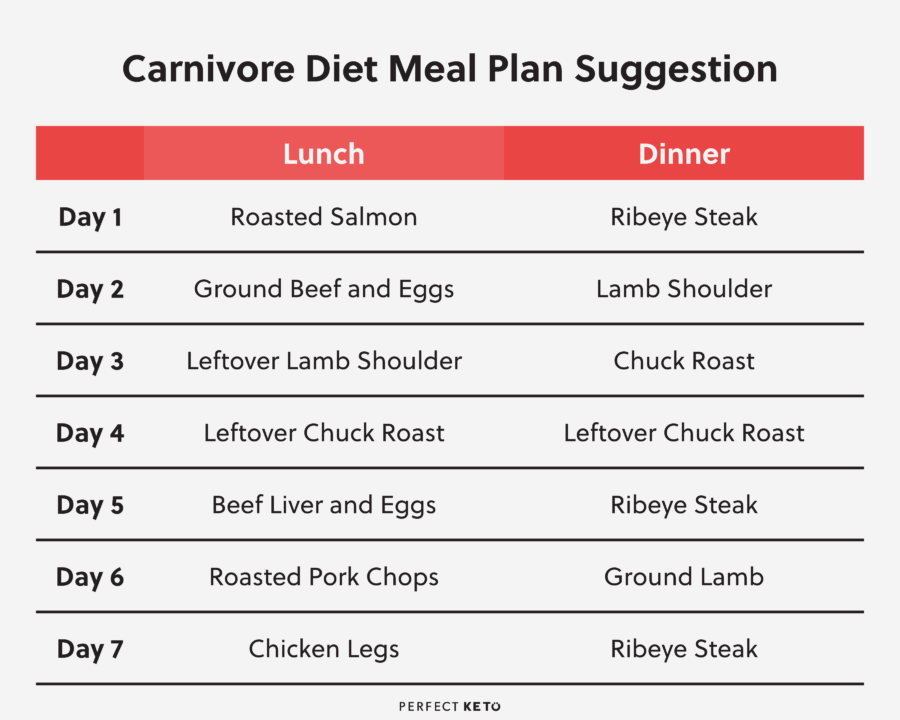The carnivore diet involves consuming only animal-based foods, excluding plants and carbs.
CUPERTINO, CALIFORNIA | NOW THEN DIGITAL — A carnivore diet meal plan includes only animal-based foods, such as meat, eggs, and dairy, with zero carbohydrates.
Diana Rodgers, RD, of Sustainable Dish, notes, “The carnivore diet often follows paleo or keto.” Paleo emphasizes fresh fruits, veggies, grass-fed meats, and seafood while cutting sugars, grains, dairy, and legumes.
Unlike other high-protein, low-carb diets, the carnivore diet permits no carbs, focusing solely on animal-derived foods, as explained by Kelly Schmidt, RD.
Foods allowed on the carnivore diet:
- Meat: beef, bison, elk, pork, etc.
- Fish and seafood: salmon, tuna, shrimp, etc.
- Eggs
- Dairy (if tolerated): cheese, butter, heavy cream
- Animal fats: tallow, lard, duck fat
- Bone broth
- Salt and pepper
It’s a controversial diet, and consulting a healthcare provider before starting is advised.

Benefits of the Carnivore Diet
Weight Loss
- Rapid weight loss due to the diet’s low-carb, high-protein nature.
- Elimination of carbohydrates forces the body to burn stored fat for energy, leading to weight loss.
Improved Digestion
- Relief from digestive issues like bloating, gas, and IBS reported by many.
- Absence of hard-to-digest plant compounds gives the digestive system a break and promotes better digestion.
Increased Energy Levels
- Steady energy from protein and fat, reducing energy crashes and spikes associated with blood sugar fluctuations.
Getting Started on the Carnivore Diet
Food Choices
- Focus on high-quality animal products like grass-fed beef, pasture-raised poultry, wild-caught fish, and organ meats.
- Avoid processed meats; opt for fresh, unprocessed options.
Meal Planning
- Plan meals in advance for nutrient variety and to avoid deficiencies.
- Include different animal products like various cuts of meat, eggs, and seafood.
Nutrient Considerations
- While the diet provides many essential nutrients, monitor specific nutrients that may be lacking.
- Consider supplements or specific food choices to meet nutrient needs, e.g., vitamin C from organ meats or omega-3 fatty acids from fish.
Sample Carnivore Diet Meal Plan
Breakfast
- Scrambled eggs with bacon
- Grass-fed beef patty
Lunch
- Grilled chicken thighs
- Salmon fillet
Dinner
- Ribeye steak
- Lamb chops
The carnivore diet can be challenging but rewarding for weight loss, improved digestion, and increased energy. Follow a comprehensive meal plan and address nutrient needs. Consult a healthcare professional before making significant dietary changes.

How Many Meals a Day Are Recommended on a Carnivore Diet
The recommended number of meals on a carnivore diet varies. Options include eating once to twice a day, having three meals, or opting for two meals daily.
A survey found that 64% of carnivore dieters ate twice a day, 17% ate less than once daily, 17% ate three or more times, and 2% ate once a day. Prioritize listening to your body and eating to satisfaction. Always consult a healthcare provider before starting any diet, especially the controversial carnivore diet.
The recommended number of meals on a carnivore diet varies. Some suggest 1-2 meals a day, while others prefer 3 meals. In a survey, 64% ate twice a day, 17% ate less than once, 17% ate 3+ times, and 2% ate once. Listen to your body and eat until full.
What Are Some Potential Health Benefits and Risks of a Carnivore Diet
The carnivore diet, solely animal-based, has potential health benefits like improved digestion, reduced inflammation, stable energy, mood enhancement, weight loss, and blood sugar control.
Risks include lacking essential nutrients like fiber and antioxidants, high saturated fat and cholesterol levels (raising heart disease risk), increased risk of serious health conditions, extreme restrictiveness, and safety concerns for some individuals.
A well-rounded diet with a variety of foods is generally recommended for better health.
The carnivore diet involves potential benefits like improved digestion, reduced inflammation, stable energy, mood enhancement, weight loss, and blood sugar control. Risks include nutrient deficiencies, high saturated fat and cholesterol, increased heart disease and cancer risk, and long-term sustainability challenges.

How Long Does It Take To See Results From a Carnivore Diet
Results on a carnivore diet vary:
- – Days 1-3: May not feel great due to lower blood sugar.
- – Days 2-5: Real fat loss begins, and you feel better.
- – Days 7-17: Decreased hunger and mental clarity increase.
- – Days 8-18: Rapid fat loss in a calorie deficit.
- – Day 15 onwards: Increased energy and better sleep.
- – 21 days: Some changes, but full transition takes 4-6 weeks.
- – Few days to few weeks: Some see results after the first meal.
- – 3-6 weeks: Notice more significant benefits, including weight loss, improved digestion, and higher energy.
- – 2 weeks to 6 months: Optimal health benefits may take up to six months.
Results depend on age, gender, activity level, and overall health. Consult a healthcare provider before starting any diet.
Results on a carnivore diet differ from person to person. Some may experience changes within days, such as improved energy and mental clarity. Fat loss typically begins after the first week, with noticeable changes in hunger and body composition. The timeline varies, but optimal benefits may appear after 3-6 weeks or up to six months. Consult a healthcare provider before starting any diet.
Editor’s Note: If you find any of our content to be inaccurate or outdated, please contact us at press@nowthendigital.com

















